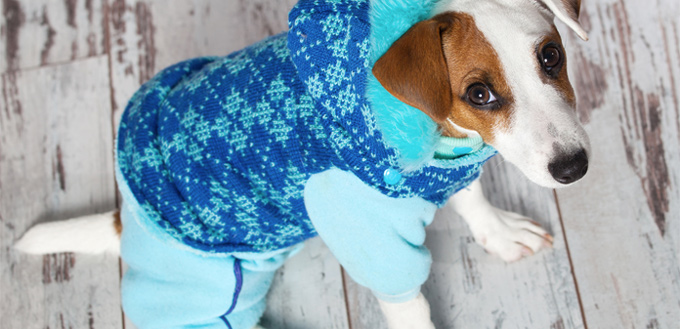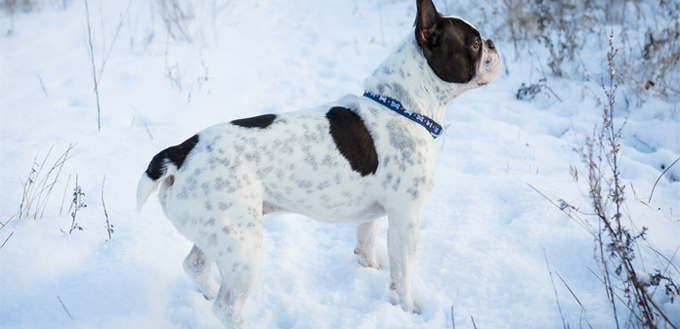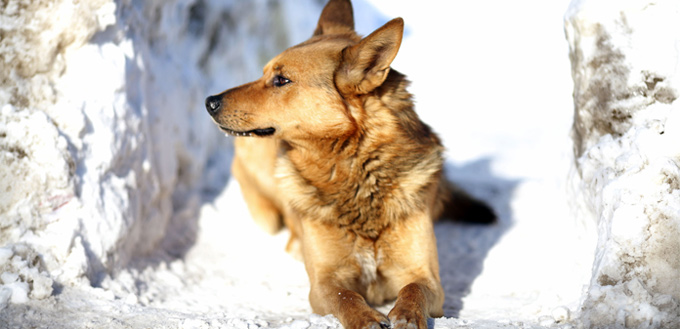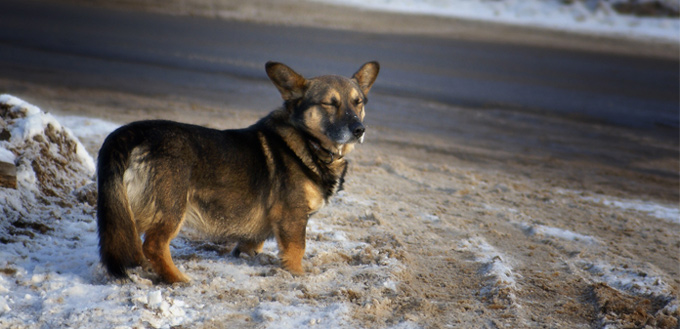Many dog owners assume because their pets have a coat of fur they can endure cold better than we humans can. This is not always the case. Just like us, these fur-coated guys are accustomed to warm indoor shelters, so, cold weather can be harsh on them. Make sure you keep your dog warm this cold season to mitigate all potential risks to your canine friend.
Do Dogs Get Cold?
Yes, dogs get cold, regardless of their built-in shielding layers. It’s a common misconception that dogs do not require any protection from cold besides their furry coat and their skin. However, this is rarely the case. During the cold weather, the inside is not warm enough for dogs; they can still get cold while inside.
Is Your Dog Warm Enough?

1. Understand Your Dog
All dogs are not created equal. An outdoor temperature might feel warm enough for one dog and extremely unbearable for another. Once you know the factors that determine how cold your dog feels, you will be better positioned to keep your dogs warm. Here are some variables that affect how dogs react to cold.
- Coat type
Dogs that have a thick, double-layered coat are usually the most tolerant to cold. They include breeds like Newfoundlands, Serbian Huskies, and Samoyeds. That is why such breeds are common in Northern climates, and they have other behavioral, physiological and anatomical features that enable them to thrive when it’s cold. On the other hand, our canine friends who have thin coats, such as Xoloitzcuintli and Greyhounds, suffer a lot when it’s cold.
- Size
Large dogs have a small surface area to volume ratio. This means that large dogs have less of their skin exposed to the environment, so, they lose less heat than small dogs. Therefore, large dogs don’t lose as much heat as small dogs do.
- Coat color
Dogs with dark coat colors, such as black and brown, can absorb considerable amounts of heat. The heat keeps them warmer compared to their light-colored counterparts.
- Weight
Body fat is an excellent insulator of heat. Thin dogs usually get cold quicker than fat dogs. Remember that there are risks associated with overweight dogs outweigh the advantages. Thus, do not fatten up your pet during winter in a bid to keep him warm.
- Age and health
Dogs which are unwell, very old and very young are not able to regulate their body temperatures as well as compared to healthy dogs and those that are in their prime age. Vulnerable dogs, therefore, require more protection from the cold.
- Conditioning
We have all had a taste of this. Fifty degrees feel chilly in October, but after a long cold season, fifty degrees in April can make us remove out shirts. Dogs which have been exposed to cold temperature tend to handle cold temperatures better than those who aren’t.
2. Check The Weather
- Wind chill
The breeze can quickly get through a dog’s coat and quickly compromise its ability to protect and insulate against the temperature.
- Cloud cover
Cloudy days usually feel colder than sunny days because the dogs are not able to soak up the heat and keep their bodies warm.
- Dampness
Wet snow, dense fog, rain or even going for a swim can easily chill your dog, even when the air temperature is not too low.
- Activity
When dogs are active for a while, they generate a lot of heat that keeps them warm even when the temperature is relatively low.
3. Heat and Insulate the Doghouse and the Dog Bed
To ensure the comfort of your dog during severe weather, you ought to install energy efficient features in the kennel. If your dog usually lies on the cold hardwood flooring, it’s high time you change this. Consider investing in heated dog beds to keep your dog warm in his sleep. One may also raise the bed off the floor. You can also find affordable and efficient air conditioning units that are specially designed for dog houses. There is also an array of ecological insulation devices, such as solar panels, which you can use.

4. Dress Your Dog for the Weather
You might be of the opinion that dog clothing is degrading and silly, but sweaters, dog boots, and dog pajamas make sense during the cold season. Dogs use their paws to regulate heat. Ice and snow on their feet might be very uncomfortable, especially if the ice builds up in the fur around the paws. When you buy dog boots for your pet, they will keep the paws warm. Short haired breeds and small dogs are usually more comfortable in sweaters during the cold seasons.
Related Post: Best Dog Sweaters
5. Carpeting
When you lay a carpet in the dog house, you will have made a huge step towards ensuring your dog isn’t subjected to the cold concrete or hardwood flooring. Make sure you attach the carpet on the floor to prevent your pet from dragging the mat. You can add a heat lamp or any other regular light to provide warmth for the tiny space. If you decide to do this, make sure you clamp up the wires so that the dog doesn’t chew them.
6. Keep Your Dog Fat and Hydrated
Just like any other warm-blooded animal, dogs usually burn more calories during cold weather because they require extra energy to deal with the cold temperatures. This means that your pet will appreciate an additional food portion during the cold months. However, make sure you confirm with your vet as to the amount of food you should add, especially if your dog is on a special diet.
Also, remember that cold weather combined with central heating can quickly dehydrate your dog. Make sure you keep his water bowl full at all times. Avoid using a metallic feeding dish in the outdoors during cold weather.
7. Shrink the Dog House
A large dog house might look fancy, but it’s not a good thing for your dog in the cold season. Reducing the size of the kennel will help your pet to stay warm. This is because a large house accelerates heat loss. Alternatively, you can buy one of the Best Dog Houses for winter.
8. Use Straw
Straw is an affordable insulator for use in a dog house. You can replace and top it off frequently. The advantage of using the straw is that it’s not likely to freeze or stay wet. Make sure you avoid hay and any other material that might contain leaves, seeds and other content that might be trapped on your dog’s fur. Also, consider putting a pallet beneath the straw layer to ensure your pet stays off the cold, bare ground.
9. Groom or Doom
Dogs manage better in the cold weather when they have a thick and insulated coat. Bigger dogs also do well during winter because they have more insulation to handle the low temperatures. Therefore, it’s important to hold off grooming during the cold months and allow your pet to grow fur. However, make sure you trim the hair around the dog’s paws to prevent snow from getting trapped in the footpads.
10. Allow Your Dog to Stay in Your House
Keep your door open to the dog. Even though dogs that are accustomed to cold weather can handle severe temperatures, make sure that you allow them to come into your house. So, you may want to open your door often or use an electronic dog door. Keep some blankets for your pets inside the house, which you can use to cover them when they visit you. Also, never allow your dog to stay in the car overnight.

How to Tell if Your Dog is Too Cold
Dogs can’t talk, but they can send signs when they are not comfortable.
- Shivering or trembling
Dogs react to low temperatures similarly to how human beings do. If you notice that your pet is trembling or quivering, there is a possibility that they are feeling too cold. Trembling, shaking and shivering are ways that the body uses to keep warm and increase internal temperature. Remember that they might also be signs of excitement, stress or fear.
- Lethargy
Extreme temperatures might make the dog to feel week or tire his muscles. If your pet feels lethargic or is moving slowly, then they might be too cold. Dogs that are jumping or running around are enjoying playing in the snow. On the other hand, those that are motionless and curled up are trying their best to conserve heat.
- Sleeping
If your dog is sleeping more than she usually does, she might be trying to conserve heat because of the low temperatures. It could also be a symptom of hypothermia, which is an illness that results from cold temperatures.
- Cold body or ears
If you suspect that your pet is feeling extreme cold, try feeling his ears. If the ears feel cold, mostly at the edges, it’s a sign that the body is struggling to stay warm. At this point, consider taking him inside the house and keep him warm.
- Restlessness
Another sign that your pet is too cold is when he is whimpering, whining or even barking excessively. If your dog rarely whimpers, and he starts doing so uncontrollably, he could be uncomfortable.
- Hiding or looking for shelter
If your pet is attempting to hide under or behind things, it’s a sign that she is trying to preserve heat. Make her warm right away.
Preventing Cold Weather Health Risks for Dogs
Cold weather is dangerous to your dog. You ought to understand common cold weather hazards for your dogs so that you can mitigate the risks.
1. Dogs Can Get Hypothermia
This is a severe cold weather condition, which occurs when your dog spends a lot of time in the cold, and the temperature goes beyond the normal. The ideal temperature should be between 101 F, and 102 F. temperatures that are below 99 degrees or above 104 are an indication of an emergency, and you need to contact the vet immediately.
So, why is hypothermia terrible for your dog?
Hypothermia compromises the central nervous system and might affect the blood flow and the heart rate. It also deteriorates the immune system and reduces the breathing rate. The effects are often life-threatening. Sometimes dogs go into a comma when they suffer hypothermia.
How can you Tell if your Dog has Hypothermia?
- In mild instances, the dog will shiver, and his ears and feet will become cold.
- As the condition progresses, the breathing rate will decrease, and her muscles will stiffen. Your pet might also become unresponsive.
When you notice these symptoms, contact a vet so that he can treat your dog before the condition worsens.
2. Dogs Can Get Frostbite
Frostbite occurs when the body channels blood away from the skin in a bid to keep the body warm. When your dog stays in the cold for a prolonged period, the tissues that undergo restricted blood flow might freeze and eventually die. To avoid this condition from happening, make sure you do not leave your dog outside when the temperature is below 320 F. Sweaters and dog boots can help but bringing them into the house is usually the best solution.

How bad is frostbite for your dog?
Tissues might freeze; thus resulting in chronic tissue damage. The most affected parts are the ears, legs, paws, tail and the nose.
How can I tell if my pet has frostbite?
- Skin ulcers and blisters
- Ice forming on a section of the skin
- Discoloration of the skin
- Skin that feels brittle or cold to touch
- As the dog gets warm, the affected part might become inflamed, painful and red
Steps to take if you think that your dog has frostbite
- Avoid rubbing or massaging the affected part
- Make your dog warm immediately using blankets or towels
- Use tepid water on the affected part
- Don’t use direct dry heating such as a hair dryer or a heating pad
- Avoid giving your dog any medication unless a vet instructs you to
- Take your dog to a veterinary
3. Low Temperatures Might Irritate Your Dog’s Arthritis
If your dog has arthritis, it might suffer hardships during the cold season. Low temperatures accelerate inflammation in the joint area. That is why you should keep your dog moving when it’s cold because a sedentary lifestyle might worsen the symptoms of arthritis. Take short walks with your dog and keep him warm.
Sources:
- Laura Playforth, 15 Tips on How to Keep Your Pet Warm and Safe in Freezing Weather, VetsNow
- Monica Weymouth, How to Keep a Dog Warm in Winter Weather, PetMD
- How to Keep Dogs Warm in the Winter, Best Friends Animal Society
- Cold Weather Animal Safety, American Veterinary Medical Association







